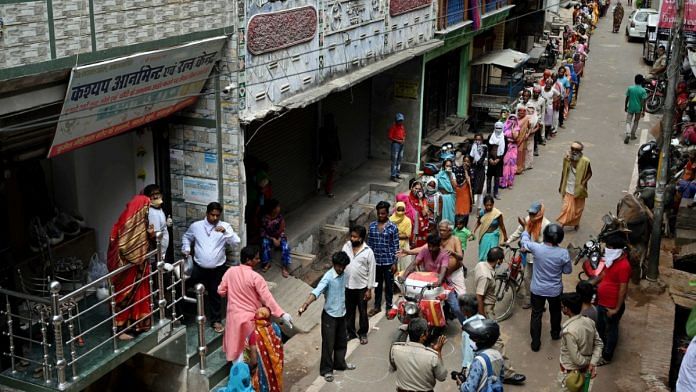The Chinese government alerted the World Health Organization (WHO) of several cases of the coronavirus disease (Covid-19) on December 31, 2019, and reported the first death on January 11. India discovered its first case a month later (January 30) and had its first death two months later (March 11). It is clear that Covid-19 has largely been driven by human-to-human transmission, forcing public health officials to announce social distancing as an effective way to drive down the virus’s reproductive numbers (known as R0, and pronounced as R naught), meaning the average number of new infections generated by each infected person.
For the epidemic to begin to end, the reproduction rate has to drop below one. Based on a mathematical model, a multi-author paper published in the March 16 issue of Science cautioned that undocumented infections are responsible for nearly 80% of the total documented cases in China, and that this single factor could facilitate rapid dissemination of the coronavirus. Those with undocumented infections often experience mild to no symptoms and can go unrecognised by the health system, thereby increasing the risk of the virus’ spread.
During the first half of January, before China imposed a complete lockdown in the affected province, the R0 of the virus had risen to 2.38, indicating a high capacity for sustained transmission. China was quick to announce a complete lockdown on January 23. Subsequently, the R0 plummeted below one, suggesting containment of the epidemic with only a marginal increase, if any, in new infections, and new deaths for weeks on end. This is the basis of a lockdown.
What is not clear, however, is the length of the period for these measures to remain in force to keep the infection R0 below one for a reasonable period, and to prevent a possible rebound after the control measures are relaxed. Do regional and population-specific factors play a role in this?
Also read: Pay private labs to test for Covid-19, it’s the best way to start India’s economic recovery
Low positivity rate in India is encouraging
India imposed a similar lockdown on March 22, exactly two months after Wuhan, first as a people’s curfew on an experimental basis, followed quickly by a nationwide lockdown from March 25. Two questions are being asked now: First, did India succeed in containing the disease as effectively as China? Second, India has a prevalence of tuberculosis, and persistent BCG vaccination has helped boost robust innate (pre-existing) as well as adaptive immunity in the Indian population. So will this broad-based immunity help India weather Covid-19?
An analysis of data, till April 8, reveals interesting trends. With over 120,000 tests done, the rate of positive cases in India with densely-populated regions is 4.5-5.0%, as compared to much higher figures in hotspot European nations and the United States. India is yet to start testing clusters with high rates of Covid-19. However, based on the expanded testing standards, the low positivity rate is encouraging. What is even more remarkable is the almost near lack of severe and critical cases and limited mortality.
But then India is not China or Europe where most infections and deaths are concentrated in ageing populations. The ministry of health and family welfare has put forward a set of interesting figures. Consistent with global patterns, 73% of Covid-19 patients in India are male and around 40% are in the 20-40 years age group. But only about 17% of the patients are senior citizens (60-80 years), though there is a higher proportion of deaths among them. These are the documented figures and perhaps community surveillance through rapid antibody tests will throw further light on as-yet-undocumented figures and defy the trends observed so far.
Why the elderly must remain indoors
How does a host immune system recognise the virus as an enemy and proceed to eliminate it? Once the lymphocytes recognise the virus as foreign, the foot soldiers in this fight (cytokines) are mobilised. They set off a cascade of signals to killer T-cells to marshal an effective response. Usually, the stronger this immune response, the quicker the chances of thwarting an infection. This is why younger people remain less vulnerable to the coronavirus. Once the enemy is defeated, the immune system returns to normal and generates “Memory T-cells” that are ready to attack more quickly, should the same infection re-enter the body.
In most cases, that is what happens. However, in some Covid-19 cases (here the exact figures could vary among populations), age notwithstanding, the immune system continues to remain in an agitated state, even if the virus no longer remains a threat. It continues to release cytokines, almost like a storm, which instead of doing any good to the body, attacks multiple organs, leading to death. The immune system in the elderly is in a state of immune senescence, and thus they must remain indoors and not interact with the young since many of the latter could be asymptomatic carriers. This is also the case with those (age no bar) who have diabetes, lung or kidney disease or are immune-compromised.
India has done exceedingly well so far. The challenge is now to sustain the benefits of the lockdown and the added immunity that the population enjoys due to the microbial load. The next few weeks are crucial; lifting the lockdown, even temporarily, is not advisable.
By special arrangement with ![]()
Also read: App for milk, vendors at the gate — how Delhi-NCR’s hotspots managed on Day 1 of ‘sealing’






